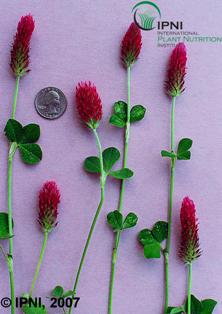Crimson Clover
Adaptation
- Coastal Plain and lower Piedmont.
- Fairly tolerant of soil acidity but does not tolerate poor drainage.
Establishment
Because this species is often seeded with multiple grass and/or legume species, see Establishment of Cool Season Annual Legumes for more details. Also, because this species is small seeded, see Seeding Methods for Small Seeded Legumes for details on how to successfully plant.
Recommended Varieties
AU-Robin
Dixie would be acceptable if AU-Robin is not available. Chief and Tibbee may also be acceptable, but their seed may be limited.
In-Depth
 Crimson clover is an excellent winter annual legume and often serves as a benchmark by which other cool season annual legumes are compared. Crimson furnishes some grazing in late fall and winter and abundant grazing in early spring. Crimson matures (flowers) earlier in spring than the other annual clovers, produces high yields even in cool winters, and has a shorter grazing season. Several varieties are now available that mature very early. This allows it to grow, be utilized, add biologically-fixed N to the soil, and die with minimal competition with warm season perennial grasses. It grows best on well-drained soils and is frequently used in mixtures with ryegrass and small grains for winter grazing. It is also commonly used to overseed bermudagrass and bahiagrass pastures. Unfortunately, crimson produces relatively few hard seed and its seed heads are often damaged by clover head weevils. As a result, crimson clover usually does not reseed well in a grazing system.
Crimson clover is an excellent winter annual legume and often serves as a benchmark by which other cool season annual legumes are compared. Crimson furnishes some grazing in late fall and winter and abundant grazing in early spring. Crimson matures (flowers) earlier in spring than the other annual clovers, produces high yields even in cool winters, and has a shorter grazing season. Several varieties are now available that mature very early. This allows it to grow, be utilized, add biologically-fixed N to the soil, and die with minimal competition with warm season perennial grasses. It grows best on well-drained soils and is frequently used in mixtures with ryegrass and small grains for winter grazing. It is also commonly used to overseed bermudagrass and bahiagrass pastures. Unfortunately, crimson produces relatively few hard seed and its seed heads are often damaged by clover head weevils. As a result, crimson clover usually does not reseed well in a grazing system.
Dr. Dennis Hancock
Forage Extension Specialist
Crop & Soil Sciences Dept.
